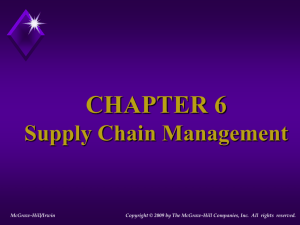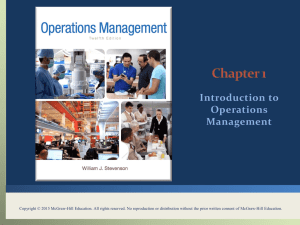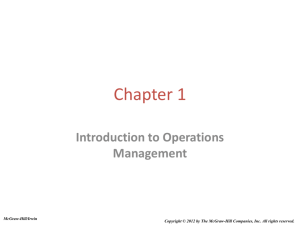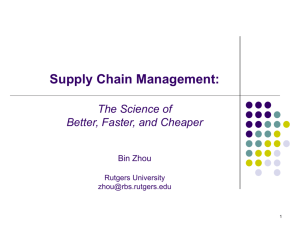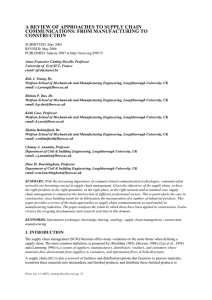LECTURE 15
advertisement
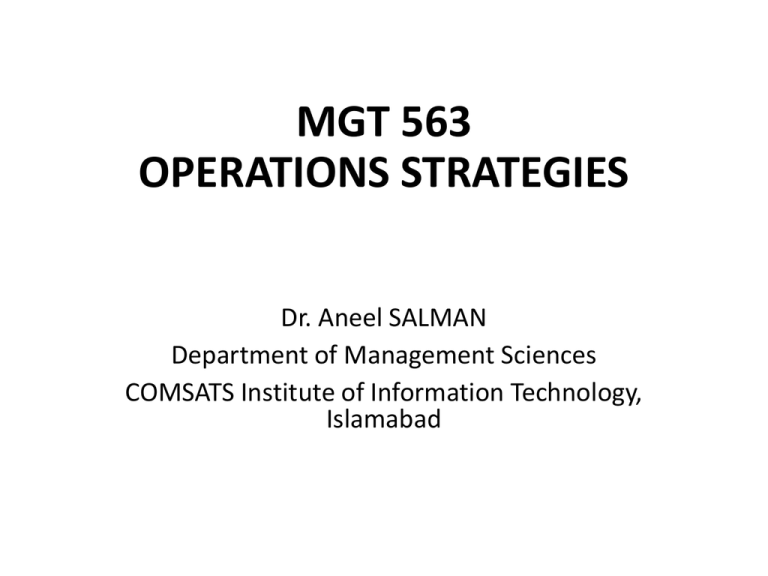
MGT 563 OPERATIONS STRATEGIES Dr. Aneel SALMAN Department of Management Sciences COMSATS Institute of Information Technology, Islamabad Recap Lecture 14 • What kind of capacity is needed? • How much capacity is needed to match demand? • When more capacity is needed? • Where facilities should be located (location) • How facilities should be arranged (layout) Why the Interest in Supply Chains? Its Import? Why the Interest in Supply Chains? Its Import? • Dealing with uncertain environments – matching supply and demand – – – – Boeing announced a $2.6 billion write-off in 1997 due to “raw materials shortages, internal and supplier parts shortages and productivity inefficiencies” U.S Surgical Corporation announced a $22 million loss in 1993 due to “larger than anticipated inventories on the shelves of hospitals” IBM sold out its supply of its new Aptiva PC in 1994 costing it millions in potential revenue Hewlett-Packard and Dell found it difficult to obtain important components for its PC’s from Taiwanese suppliers in 1999 due to a massive earthquake • U.S. firms spent $898 billion (10% of GDP) on supply-chain related activities in 1998 Why the Interest in Supply Chains? Its Import? • Shorter product life cycles of high-technology products – – Less opportunity to accumulate historical data on customer demand Wide choice of competing products makes it difficult to predict demand • The growth of technologies such as the Internet enable greater collaboration between supply chain trading partners – – If you don’t do it, your competitor will Major buyers such as Wal-Mart demand a level of “supply chain maturity” of its suppliers • Availability of SCM technologies on the market – Firms have access to multiple products (e.g., SAP, Baan, Oracle, JD Edwards) with which to integrate internal processes • • • • • Why the Interest in Supply Chains? Its Import? Greater sharing of information between vendors and customers. Horizontal business processes replacing vertical departmental functions. Shift from mass production to customized products. Increased reliance on purchased materials and outside processing with a simultaneous reduction in the number of suppliers. Value that can be extracted by manufacturing is declining as the cost of materials and distribution climbs. Why the Interest in Supply Chains? Its Import? • Greater emphasis on organizational and process flexibility. • Necessity to coordinate processes across many sites. • Employee empowerment and the need for rulesbased real time decision support systems. • Competitive pressure and compressed product life cycles to introduce new products more quickly. Why the Interest in Supply Chains? Its Import? • Companies are restructuring their production facilities on a global basis. • Low-Cost, High-Volume Data Processing and Communication (Internet) are revolutionizing control systems. What the supply chain is not • Among the misunderstanding evidenced, supply chain management is not: – – – – – – – – – inventory management logistics management supplier partnerships driven from the supply side a shipping strategy distribution management the logistics pipeline procurement management a computer system Why Is SCM Difficult? Uncertainty is inherent to every supply chain – – – – Travel times Breakdowns of machines and vehicles Weather, natural catastrophe, war Local politics, labor conditions, border issues The complexity of the problem to globally optimize a supply chain is significant – – – Minimize internal costs Minimize uncertainty Deal with remaining uncertainty Why Is SCM Difficult? • • • • • • • • Lack of guidelines for creating alliances with supply chain partners. Failure to develop measures for monitoring alliances. Inability to broaden the supply chain vision beyond procurement or product distribution to encompass larger business processes. Inability to integrate the company's internal procedures. Lack of trust inside and outside a company. Organizational resistance to the concept. Lack of buy-in by top managers. Lack of integrated information systems and electronic commerce linking firms. What is Supply Chain Management? Some Definitions…. A process of collaboration between trading partners that manages the flow of products, information, and funds from point of RM to consumption. What Is the Supply Chain? • Also referred to as the logistics network • Suppliers, manufacturers, warehouses, distribution centers and retail outlets – “facilities” Suppliers Manufacturers Warehouses & Customers Distribution Centers and the • Raw materials • Work-in-process (WIP) inventory • Finished products that flow between the facilities Transportation Costs Material Costs Transportation Costs Transportation Manufacturing Costs Inventory Costs Costs The Supply Chain Suppliers Manufacturers Transportation Costs Material Costs Warehouses & Distribution Centers Transportation Costs Manufacturing Costs Customers Transportation Costs Inventory Costs The Supply Chain – Another View Plan Source Suppliers Material Costs Make Manufacturers Deliver Warehouses & Distribution Centers Buy Customers Transportation Transportation Costs Transportation Costs Manufacturing Costs Inventory Costs Costs Plan Source Make Deliver Buy • A set of approaches used to efficiently integrate – – – – Suppliers Manufacturers Warehouses Distribution centers • So that the product is produced and distributed – – – In the right quantities To the right locations And at the right time • System-wide costs are minimized and • Service level requirements are satisfied Supply Chain Drivers THE PAST, PRESENT AND FUTURE OF SCM The Past • • • • • • 3000 BC: Transportation Efficiency 1950AD: Total Cost Awareness 1955: Customer Service 1960: Inventory Management Focus, Cost Control 1965: Comprehensive Outsourcing 1970s: Material Requirement Planning (MRP) & Bill of Materials (BOM) - Operations Planning The Past • 1975: Operational Integration and Quality (Six Sigma) • 1980s: Manufacturing Resource Planning (MRPII), JIT - Materials Management, Logistics • 1985: Financial Positioning and Operational Excellence • 1990s: SCM – Enterprise Resource Planning (ERP) “Integrated” Purchasing, Financials, Manufacturing, Order Entry and GLOBALIZATION • 1995: Customer Relationship and Enterprise Extension The Present • 2000s: Optimized “Value Network” with Real-Time Decision Support; Synchronized & Collaborative Extended Network AND Supply Chain Integrative Management • 2005: Responsive Supply Chain Management 2008: Supply Chain Sustainability • 2010+: Multi-firm Collaboration 2010 AND BEYOND • Multi-Firm Collaboration • Talent and Resource Swapping – “Federating” • Knowledge-Dependent Process Automation: – Intelligent Probotics • Extreme Postponement: – •Driven by Demand “Sensing”, not Forecasting • Nanogenome Supply Chain Technology From Push to Pull Making Responsiveness- An Operational Reality • Two Extreme Models: – Similar in concept to pure competition and pure monopoly • Anticipatory Push Business Model • Response-driven Business Model Anticipatory Business Model • Forecast Driven • Push Mentality – Allocation Paced Responsive Business Model • Endcast Driven • Pull Mentality – Requirements Paced Steps To Achieving Responsiveness 1. Achieving Integrated Logistics 2. Leveraging Collaborative Management 3. Achieving EERS Value Performance 1. Achieving Integrated Logistics The process of moving and positioning inventory to meet customer requirements at the lowest possible total cost to serve. – Time and Place Positioning – Lowest Total Cost – Asset Minimization – Supply Chain Connectivity 2. Leveraging Collaborative Management Or SC Collaboration (SCC) SCC – What Is It? • Many different definitions depending on perspective • The means by which companies within the supply chain work together towards mutual goals by sharing – – – – – – – Ideas Information Processes Knowledge Information Risks Rewards • Why collaborate? – – Accelerate entry into new markets Changes the relationship between cost/value/profit equation • Cornerstone of effective SCM • The focus of many of today’s SCM initiatives • The only method that has the potential to eliminate or minimize Retailers the Bullwhip effect Suppliers Synchronized Production Scheduling Manufacturer Collaborative Demand Planning Collaborative Product Development Collaborative Logistics Planning •Transportation services •Distribution center services Logistics Providers Distributors/ Wholesalers Its Benefits CUSTOMERS MATERIAL SUPPLIERS Improved customer service More efficient use of human resources Reduced inventory Lower freight costs Lower warehousing costs Faster and more reliable delivery Lower material acquisition costs Lower capital costs Fewer stockout conditions Reduced depreciation Lower fixed costs Source: Cohen & Roussel Reduced inventory Increased revenue Lower order management costs Higher Gross Margin Better forecast accuracy Better allocation of promotional budgets SERVICE SUPPLIERS SC Collaboration Spectrum Extent of Collaboration Extensive Not Viable Limited Synchronized Collaboration – – – – – – Coordinated Collaboration Low Return Many Few Number of Relationships Source: Cohen & Roussel Information systems Systems infrastructure Decision support systems Planning mechanisms Information sharing Process understanding • Higher levels of collaboration imply the need for both trading partners to have equivalent (or close) levels of supply chain maturity • Synchronized collaboration demands joint planning, R&D and sharing of information and processing models Cooperative Collaboration Transactional Collaboration • The green arrow describes increasing complexity and sophistication of: – Movement to real-time customer demand information throughout the supply chain Successful SC Collaboration • Try to collaborate internally before you try external collaboration • Help your partners to work with you • Share the savings • Start small (a limited number of selected partners) and stay focused on what you want to achieve in the collaboration • Advance your IT capabilities only to the level that you expect your partners to manage • Put a comprehensive metrics program in place that allows you to monitor your partners’ performance • Make sure people are kept part of the equation – – Systems do not replace people Make sure your organization is populated with competent professionals who’ve done this before 3. The EERS Value Performance Model • Service Excellence - Effectiveness • Cost Minimization and Avoidance - Efficiency • Customer Value Generation - Relevancy Continuous Improvement - Sustainability Examples of Supply Chain Hershey’s Supply Chain Inbound Traffic Outbound Traffic • cocoa beans and sugar • warehousing and inventory control • 1B pounds of chocolate annually, 30M kisses per day • 12 third party manufacturers • 2 regional distribution centers • 14 warehouses • 12 channels of distribution Black & Decker’s Supply Chain • • • • • • 4,000 to 6,000 suppliers worldwide 70 worldwide manufacturing plants 20 distribution centers Markets products in 58 countries Supplies market on JIT basis 3-5 day order cycle time, 90% fill rate

